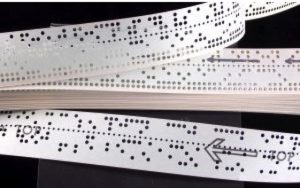History (1846): Punched Tape
Primary mean of mass storage for computers in 1960s
This is a Press Release edited by StorageNewsletter.com on September 3, 2018 at 2:28 pmThis article was published by the Museum of Obsolete Media.
Punched tape (1846 – 1980s)

Punched tape or perforated tape was an early form of data storage, developed from interlinked cards such as those used on the Jacquard loom.
In 1846, punched tape was used for sending telegrams. Operators could type a message to the paper tape, and then sent the message at the maximum line speed from the tape.
Various encoding schemes were used over time, beginning with Baudot with 5 holes, and culminating in ASCII.
A row of narrower holes served to feed the tape.
When the first minicomputers were being released, manufacturers turned to the existing mass-produced ASCII teleprinters and punched tape became a popular medium for low cost minicomputer data and program storage. Punched tape and punched cards became the primary means of mass storage for computers in the 1960s.
In the 1970s, computer-aided manufacturing equipment often used paper tape, as paper tape readers were smaller and much less expensive than punched card or magnetic tape readers. Premium black waxed and lubricated long-fibre papers, and Mylar film tape were invented so that production tapes for these machines would last longer.
Punched tape had a low information density and took a long time to load, and more than a few dozen kilobytes are impractical to handle in punched tape format.
Unlike magnetic tape though, punched tape can be read decades later if acid-free paper or Mylar film was used, and can even be decoded visually if necessary.












 Subscribe to our free daily newsletter
Subscribe to our free daily newsletter


